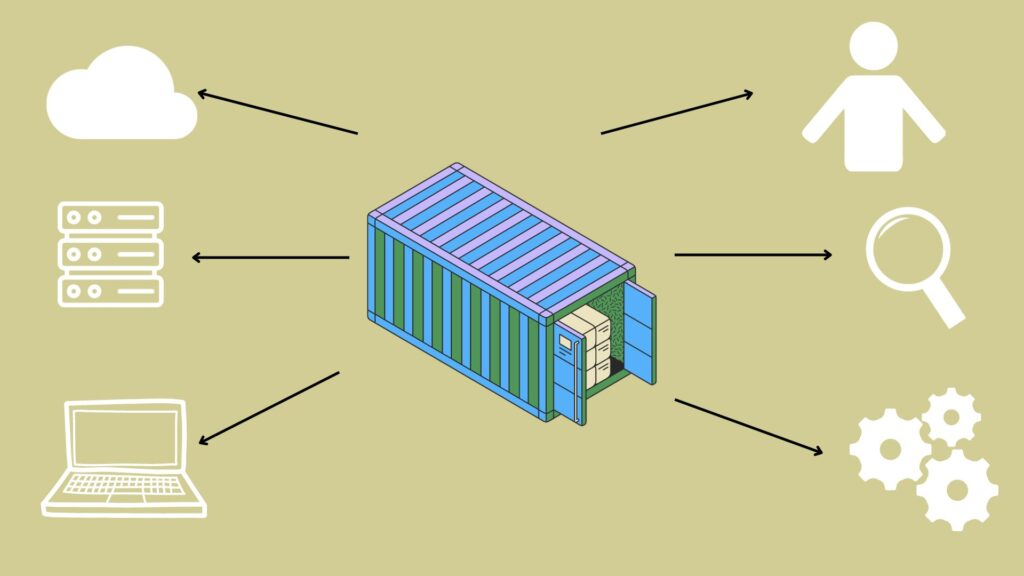Today, evolving technology has become an important aspect of maintaining the sustainability and competitiveness of companies in the digital era. To increase flexibility, scalability, and operational efficiency by using technology, many companies are starting to turn to microservices and containers. In this article, we will explore the definition, benefits, and relevance of microservices and container development for companies.
What is Microservices?
The word “microservices” was first introduced by Dr. Peter Rogers during a presentation at a cloud computing conference in 2005. The definition of microservices is an architectural design aimed at creating an application that has various units of service but is still interconnected. Each unit of service in an application developed in microservices performs a different function but still supports each other.
Spotify is an example of an app that utilizes microservices to create an efficient system and avoid the complexity of a monolithic system. They break down the system into a variety of stand-alone microservices, each with a specific purpose such as a search engine, user behavior analysis, automated playlists, content tagging, and more. With this isolation between services, Spotify achieves consistency in customer service, allowing the company to continuously improve without disrupting existing services.
Benefits of Using Microservices
The following benefits of using microservices are:
1. Companies can achieve better flexibility, scalability, and maintainability.
2. Developer responsibilities will be clearer because the team will be assigned based on components or services in microservices.
3. Each service formed in the microservices architecture can be programmed into various languages and run on various platforms, thus offering flexibility in using the best tools in each project.
4. It enables better data security and compliance, as each service is responsible for a specific task, making it easier to implement security at each service level.Microservices support rapid software delivery, foster innovation and creativity, and align with Agile Manifesto and DevOps practices.
From the various benefits offered, keep in mind that using microservices also has challenges, including increasing complexity, the importance of maintaining data consistency and synchronization, regular monitoring to maintain system health, testing, and debugging difficulties, and lack of standardization.
So, What are Containers?
The definition of container is a technology that allows you to package your application and all the necessary dependencies into a single ‘container’ so that the application can run consistently in various environments. As a result, containers can save you from compatibility issues that may occur when running applications on several different systems or environments. Docker and Kubernetes are well-known examples of container technology in the company.

Benefits of Using Container
The following benefits of using containers are:
1. Server utilization becomes more efficient thus reducing costs
2. The process of developing applications becomes faster
3. Increased portability, where microservices and applications in containers can operate consistently on various systems
4. Easier adoption of microservices
5. Faster startup process than virtual machine (VM)
What is the Relationship between Microservices and Containers?
When Microservices and Containerization are used together, companies can achieve tremendous efficiency in application development and management. Microservices in their architectural design involve several separate services in a single application, and the way to integrate all those services is through a container.
So, the relationship with microservices is the use of containers that can hold all applications and their dependencies in a microservices architecture. In addition, the container is also a very suitable intermediary for deploying microservices, because the container can be operated within seconds. Therefore, if a failure occurs, it can be handled quickly.
How Microservices Work in Containers
Microservices in containers can make the job of developers in your company easier. What’s the reason? Because each component of microservices is relatively small and can perform its tasks (decentralized). This allows developers to handle other specific tasks without getting involved in the complexity of the application. In addition, containerized applications give developers the freedom to code each service in the most appropriate language.
Containers are also portable and easy to use in continuous integration and continuous delivery flows, which can lead to increased productivity. Each microservices also has a smaller risk of cyber attack and is isolated from other microservices. This makes it more difficult for security breaches to spread from one container to another.
Need a Container Monitoring Tool?
After knowing how containers work together with various service units in microservices, you need monitoring practices to keep everything running optimally. The recommended container monitoring tool that you can trust is Netmonk Prime. You can get the container monitoring tool by using the server monitoring module from Netmonk Prime.
The container monitoring feature from Netmonk Prime can help you monitor the container name (hostname), container status (running, paused, stopped), server availability (uptime), CPU, memory usage, and network data in just 1 dashboard. In addition, the advantages of using Netmonk Prime are real-time monitoring, proactive notifications, and reports that can be downloaded into PDF files. Very interesting, right? Let’s use container monitoring for your company now!
References:
https://theappsolutions.com/blog/development/microservice-architecture-explained/
https://blog.dreamfactory.com/what-are-containerized-microservice
https://javatechonline.com/microservices-tutorial/
https://developer.ibm.com/articles/why-should-we-use-microservices-and-containers/


